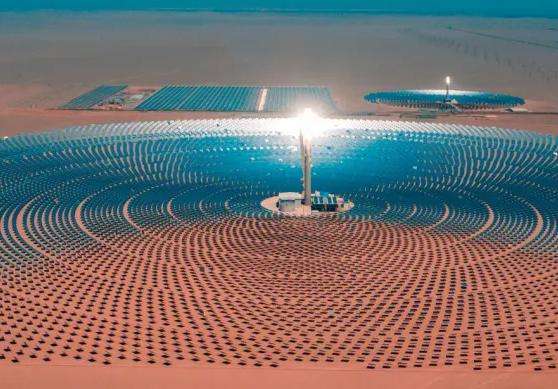The Ministry of Housing and Urban-Rural Development and the National Development and Reform Commission released a carbon peak implementation plan in the urban and rural construction sector to optimize the energy consumption structure of urban construction. Promote the integrated construction of solar photovoltaic systems in buildings and strive to achieve 50% photovoltaic coverage on the roofs of new public institutional buildings and new factories by 2025. Promote the installation of solar photovoltaic systems on the roofs of existing public buildings. Accelerate the promotion of intelligent photovoltaic applications. Actively promote the application of solar thermal energy in buildings located in areas with abundant solar energy resources and in buildings with stable hot water demand. Promote the application ofgeothermal energy and biomass energy according to local conditions and promote various electric heat pump technologies such as air sources. By 2025, the substitution rate for renewable energies in urban buildings will reach 8%. Guide the electrification of building heating, domestic hot water, cooking, etc., so that by 2030, building electricity represents more than 65% of building energy consumption. Promote the comprehensive electrification of new public buildings, with an electrification rate reaching 20% by 2030.
Opinion of the Ministry of Housing and Urban-Rural Development and the National Commission for Development and of the reform on the publication of the carbon peak implementation plan in the urban and rural construction sector
Relevant departments of the State Council, the departments of housing and urban developmentn-rural, and development departments of all provinces and autonomous regions Reform Commission, Municipal Housing and Urban-Rural Development Commission (management), Development and Reform Commission, Xinjiang Housing Production and Construction Corps and Urban Planning -Rural Development Bureau, Development and Reform Commission:
The “Implementation Plan for Carbon Peak in Urban and Rural Construction Sector” has already been released. The Dafeng Carbon Neutral Pilot Working Group has reviewed and approved it and is hereby released. to you. Please implement it conscientiously.
Ministry of Housing and Urban-Rural Development
National Development and Reform Commission
June 30, 2022
< p>< p> Solar buildings have seen decades of development in China. The first solar buildings were solar houses in China in the 195s0 and 1960, which mainly used passive technology to meet the basic needs of the population through passive design. Today, in addition to passive technology, solar energy technology has also developed active technology, which is mainly reflected in two aspects: the use of solar thermal and the use of solar photovoltaic. Photothermal use is mainly used for heating and cooling and is divided into high temperature use, medium temperature use and low temperature use according to the use temperature. Technical heating is mainly based on the use of solar energy at high temperatures, while the daily supply of domestic hot water is mainly based on the use of low temperatures. Solar photovoltaic technology mainly uses monocrystalline or polycrystalline siliconstallin to convert light energy into electrical energy. It is generally used in space shuttles, space stations or remote areas. The photovoltaic use of solar buildings is mainly used to achieve solar lighting.Solar thermal technology is widely used in China and has a good foundation for industrialization and commercialization. Solar photovoltaic technology, due to its higher cost, is not as popular as photothermal technology.
The development environment of solar buildings in China is becoming more and more favorable. In China, the Kyoto Protocol was signed on May 29, 1998, the Renewable Energy Law was approved and implemented on December 1, 2006, and the “China Medium and Long-Term Development Plan for Renewable Energy » was published on August 31. 2007. The energy saving law wasofficially implemented on April 1, 2008 and the regulations on energy saving in buildings were implemented on October 1, 2008.example". "Energy saving and emission reduction" and "energy saving and "land economy" have become one of the most used words in the construction industry. All this shows people that China's housing construction and energy problems have become general problems in Chinese society, and the. development of solar buildings in China has gradually attracted attention from all walks of life
Currently, provinces such as Jiangsu, Shandong, Hebei, Hainan and Yunnan, and cities such as Beijing, Shanghai, Shenzhen and. Dalian is already building new residential buildings below 12 floors as well as public buildings such as office buildings, schools, hospitals and hotels, China has started to enforce the implementationof solar water heating systems. Therefore, the application of solar water heating systems can become a mandatory requirement for building energy saving at the national level, so that the building energy saving target of 50 or 65% contains more connotations.
Since China's solar energy and building integration technology has fundamentally matured, the integration of solar energy and buildings is an inevitable trend in the development of Chinese solar energy utilization industry. The Chinese government's commitment to international obligations to reduce CO2 emissions and the implementation of the Scientific Outlook on Development, as well as the growing national awareness of energy saving in buildings and the environment increasingly mature real estate market, have favored the formation of a chaininterest and market-driven operational mechanism for building energy conservation, providing energy to buildings. The exploitation of solar energy offers good opportunities. It is certain that the future construction market will be one of energy saving and emission reduction, and solar buildings will usher in a spring of rapid development.














